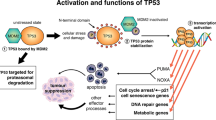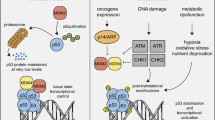Abstract
The TP53 tumour-suppressor gene belongs to a family that includes the two recently identified homologues TP63 and TP73. Overexpression of p73 can activate typical p53-responsive genes and induce apoptosis like p53. In addition, activation of p73 has been implicated in apoptotic cell death induced by aberrant cell proliferation and some forms of DNA-damage. These data together with the localization of TP73 on chromosome 1p36, a region frequently deleted in a variety of human cancers, led to the hypothesis that p73 has tumour suppressor activity just like p53. However, despite its proapoptotic activity in vitro, the lack of tumour-formation in p73 knock-out mice and primary human tumour data demonstrating overexpression of wild-type p73 currently argue against p73 being a classical tumour suppressor. Interestingly, in contrast to TP53, TP73 gives rise to a complex pattern of pro- and antiapoptotic p73 isoforms generated by differential splicing and alternative promoter usage. Therefore further insight into the function and regulation of these structurally and functionally diverse p73 proteins is needed to elucidate the role of TP73 for apoptosis and human tumorigenesis.
Similar content being viewed by others
References
El-Deiry WS. Regulation of p53 downstream genes. Semin Cancer Biol 1998; 8: 345-357.
Prives C, Hall PA. The p53 pathway. J Pathol 1999; 187: 112-126.
Oren M, Rotter V. Introduction: p53-the first twenty years. Cell Mol Life Sci 1999; 55: 9-11.
Hollstein M, Sidransky D, Vogelstein B, Harris CC. p53 mutations in human cancers. Science 1991; 253: 49-53.
Hollstein M, Shomer B, Greenblatt M, et al. Somatic point mutations in the p53 gene of human tumors and cell lines: Updated compilation. Nucleic Acids Res 1996; 24: 141-146.
Kaghad M, Bonnet H, Yang A, et al. Monoallelically expressed gene related to p53 at 1p36, a region frequently deleted in neuroblastoma and other human cancers. Cell 1997; 90: 809-819.
Trink B, Okami K, Wu L, Sriuranpong V, Jen J, Sidransky D. A new human p53 homologue. Nat Med 1998; 4: 747-748.
Yang A, Kaghad M, Wang Y, et al. p63, a p53 homolog at 3q27-29, encodes multiple products with transactivating, death-inducing, and dominant-negative activities. Mol Cell 1998; 2: 305-316.
Osada M, Ohba M, Kawahara C, et al. Cloning and functional analysis of human p51, which structurally and functionally resembles p53. Nat Med 1998; 4: 839-843.
Jost CA, Marin MC, Kaelin WG Jr. p73 is a simian [correction of human] p53-related protein that can induce apoptosis. Nature 1997; 389: 191-194.
Zhu J, Jiang J, Zhou W, Chen X. The potential tumor suppressor p73 differentially regulates cellular p53 target genes. Cancer Res 1998; 58: 5061-5065.
Ishida S, Yamashita T, Nakaya U, Tokino T. Adenovirus-mediated transfer of p53-related genes induces apoptosis of human cancer cells. Jpn J Cancer Res 2000; 91: 174-180.
Yang A, McKeon F. P63 and P73: P53 mimics, menaces and more. Nat Rev Mol Cell Biol 2000; 1: 199-207.
Pozniak CD, Radinovic S, Yang A, McKeon F, Kaplan DR, Miller FD. An anti-apoptotic role for the p53 family member, p73, during developmental neuron death. Science 2000; 289: 304-306.
De Laurenzi V, Costanzo A, Barcaroli D, et al. Two new p73 splice variants, gamma and delta, with different transcriptional activity. J Exp Med 1998; 188: 1763-1768.
De Laurenzi VD, Catani MV, Terrinoni A, et al. Additional complexity in p73: Induction by mitogens in lymphoid cells and identification of two new splicing variants epsilon and zeta. Cell Death Differ 1999; 6: 389-390.
Casciano I, Ponzoni M, Lo Cunsolo C, Tonini GP, Romani M. Different p73 splicing variants are expressed in distinct tumour areas of a multifocal neuroblastoma. Cell Death Differ 1999; 6: 391-393.
Kong XT, Valentine VA, Rowe ST, et al. Lack of homozygously inactivated p73 in single-copy MYCN primary neuroblastomas and neuroblastoma cell lines. Neoplasia 1999; 1: 80-89.
Ng SW, Yiu GK, Liu Y, et al. Analysis of p73 in human borderline and invasive ovarian tumor. Oncogene 2000; 19: 1885-1890.
Fillippovich I, Sorokina N, Gatei M, et al. Transactivation-deficient p73alpha (p73Deltaexon2) inhibits apoptosis and competes with p53. Oncogene 2001; 20: 514-522.
Chen X. The p53 family: Same response, different signals? Mol Med Today 1999; 5: 387-392.
Vousden KH. P53: Death star. Cell 2000; 103: 691-694.
Ueda Y, Hijikata M, Takagi S, Chiba T, Shimotohno K. New p73 variants with altered C-terminal structures have varied transcriptional activities. Oncogene 1999; 18: 4993-4998.
Avantaggiati ML, Ogryzko V, Gardner K, Giordano A, Levine AS, Kelly K. Recruitment of p300/CBP in p53-dependent signal pathways. Cell 1997; 89: 1175-1184.
Gu W, Roeder RG. Activation of p53 sequence-specific DNA binding by acetylation of the p53 C-terminal domain. Cell 1997; 90: 595-606.
Lill NL, Grossman SR, Ginsberg D, DeCaprio J, Livingston DM. Binding and modulation of p53 by p300/CBP coactivators. Nature 1997; 387: 823-827.
Lee CW, La Thangue NB. Promoter specificity and stability control of the p53-related protein p73. Oncogene 1999; 18: 4171-4181.
Zeng X, Li X, Miller A, et al. The N-terminal domain of p73 interacts with the CH1 domain of p300/CREB binding protein and mediates transcriptional activation and apoptosis. Mol Cell Biol 2000; 20: 1299-1310.
Zeng X, Lee H, Zhang Q, Lu H. p300 does not require its acetylase activity to stimulate p73 function. J Biol Chem 2001; 276: 48-52.
Sherr CJ. Tumor surveillance via the ARF-p53 pathway. Genes Dev 1998; 12: 2984-2991.
Qin XQ, Livingston DM, Kaelin WG Jr, Adams PD. Deregulated transcription factor E2F-1 expression leads to S-phase entry and p53-mediated apoptosis. Proc Natl Acad Sci USA 1994; 91: 10918-10922.
Hunt KK, Deng J, Liu TJ, et al. Adenovirus-mediated overexpression of the transcription factor E2F-1 induces apoptosis in human breast and ovarian carcinoma cell lines and does not require p53. Cancer Res 1997; 57: 4722-4726.
Phillips AC, Bates S, Ryan KM, Helin K, Vousden KH. Induction of DNA synthesis and apoptosis are separable functions of E2F-1. Genes Dev 1997; 11: 1853-1863.
Hsieh JK, Fredersdorf S, Kouzarides T, Martin K, Lu X. E2F1-induced apoptosis requires DNA binding but not transactivation and is inhibited by the retinoblastoma protein through direct interaction. Genes Dev 1997; 11: 1840-1852.
Wu X, Levine AJ. p53 and E2F-1 cooperate to mediate apoptosis. Proc Natl Acad Sci USA 1994; 91: 3602-3606.
Nip J, Strom DK, Fee BE, Zambetti G, Cleveland JL, Hiebert SW. E2F-1 cooperates with topoisomerase II inhibition and DNA damage to selectively augment p53-independent apoptosis. Mol Cell Biol 1997; 17: 1049-1056.
Vigo E, Muller H, Prosperini E, et al. CDC25A phosphatase is a target of E2F and is required for efficient E2F-induced S phase. Mol Cell Biol 1999; 19: 6379-6395.
de Stanchina E, McCurrach ME, Zindy F, et al. E1A signaling to p53 involves the p19(ARF) tumor suppressor. Genes Dev 1998; 12: 2434-2442.
Palmero I, Pantoja C, Serrano M. p19ARF links the tumour suppressor p53 to Ras. Nature 1998; 395: 125-126.
Zindy F, Eischen CM, Randle DH, et al. Myc signaling via the ARF tumor suppressor regulates p53-dependent apoptosis and immortalization. Genes Dev 1998; 12: 2424-2433.
Bates S, Phillips AC, Clark PA, Stott F, Peters G, Ludwig RL, Vousden KH. p14ARF links the tumour suppressors RB and p53. Nature 1998; 395: 124-125.
Stiewe T, Pützer BM. Role of the p53-homologue p73 in E2F1-induced apoptosis. Nat Genet 2000; 26: 464-469.
Irwin M, Marin MC, Phillips AC, et al. Role for the p53 homologue p73 in E2F-1-induced apoptosis. Nature 2000; 407: 645-648.
Zaika A, Irwin M, Sansome C, Moll UM. Oncogenes induce and activate endogenous p73 protein. J Biol Chem 2001; 276: 11310-11316.
Marin MC, Jost CA, Irwin MS, DeCaprio JA, Caput D, Kaelin WG Jr. Viral oncoproteins discriminate between p53 and the p53 homolog p73. Mol Cell Biol 1998; 18: 6316-6324.
Steegenga WT, Shvarts A, Riteco N, Bos JL, Jochemsen AG. Distinct regulation of p53 and p73 activity by adenovirus E1A, E1B, and E4orf6 proteins. Mol Cell Biol 1999; 19: 3885-3894.
Lissy NA, Davis PK, Irwin M, Kaelin WG, Dowdy SF. A common E2F-1 and p73 pathway mediates cell death induced by TCR activation. Nature 2000; 407: 642-645.
Levrero M, De Laurenzi V, Costanzo A, Gong J, Melino G, Wang JY. Structure, function and regulation of p63 and p73. Cell Death Differ 1999; 6: 1146-1153.
Gong JG, Costanzo A, Yang HQ, et al. The tyrosine kinase c-Abl regulates p73 in apoptotic response to cisplatin-induced DNA damage. Nature 1999; 399: 806-809.
Agami R, Bernards R. Distinct initiation and maintenance mechanisms cooperate to induce G1 cell cycle arrest in response to DNA damage. Cell 2000; 102: 55-66.
Yuan ZM, Shioya H, Ishiko T, et al. p73 is regulated by tyrosine kinase c-Abl in the apoptotic response to DNA damage. Nature 1999; 399: 814-817.
Baskaran R, Wood LD, Whitaker LL, et al. Ataxia telangiectasia mutant protein activates c-Abl tyrosine kinase in response to ionizing radiation. Nature 1997; 387: 516-519.
Shaul Y. c-Abl: Activation and nuclear targets. Cell Death Differ 2000; 7: 10-16.
Chen X, Zheng Y, Zhu J, Jiang J, Wang J. p73 is transcriptionally regulated by DNA damage, p53, and p73. Oncogene 2001; 20: 769-774.
Yang A, Walker N, Bronson R, et al. p73-deficient mice have neurological, pheromonal and inflammatory defects but lack spontaneous tumours. Nature 2000; 404: 99-103.
Irwin MS, Kaelin WG Jr. Role of the newer p53 family proteins in malignancy. Apoptosis 2001; 6: 17-29.
Tannapfel A, Wasner M, Krause K, et al. Expression of p73 and its relation to histopathology and prognosis in hepatocellular carcinoma. J Natl Cancer Inst 1999; 91: 1154-1158.
Zwahlen D, Tschan MP, Grob TJ, et al. Differential expression of p73 splice variants and protein in benign and malignant ovarian tumours. Int J Cancer 2000; 88: 66-70.
Zaika AI, Kovalev S, Marchenko ND, Moll UM. Overexpression of the wild type p73 gene in breast cancer tissues and cell lines. Cancer Res 1999; 59: 3257-3263.
Tschan MP, Grob TJ, Peters UR, et al. Enhanced p73 expression during differentiation and complex p73 isoforms in myeloid leukemia. Biochem Biophys Res Commun 2000; 277: 62-65.
Vikhanskaya F, Marchini S, Marabese M, Galliera E, Broggini M. P73a overexpression is associated with resistance to treatment with DNA-damaging agents in a human ovarian cancer cell line. Cancer Res 2001; 61: 935-938.
Di Como CJ, Gaiddon C, Prives C. p73 function is inhibited by tumor-derived p53 mutants in mammalian cells. Mol Cell Biol 1999; 19: 1438-1449.
Marin MC, Jost CA, Brooks LA, et al. A common polymorphism acts as an intragenic modifier of mutant p53 behaviour. Nat Genet 2000; 25: 47-54.
Strano S, Munarriz E, Rossi M, et al. Physical and functional interaction between p53 mutants and different isoforms of p73. J Biol Chem 2000; 275: 29503-29512.
Brooks LA, Tidy JA, Gusterson B, et al. Preferential retention of codon 72 arginine p53 in squamous cell carcinomas of the vulva occurs in cancers positive and negative for human papillomavirus. Cancer Res 2000; 60: 6875-6877.
Tada M, Furuuchi K, Kaneda M, et al. Inactivate the remaining p53 allele or the alternate p73? Preferential selection of the Arg72 polymorphism in cancers with recessive p53 mutants but not transdominant mutants. Carcinogenesis 2001; 22: 515-517.
Gaiddon C, Lokshin M, Ahn J, Zhang T, Prives C. A subset of tumor-derived mutant forms of p53 down-regulate p63 and p73 through a direct interaction with the p53 core domain. Mol Cell Biol 2001; 21: 1874-1887.
Author information
Authors and Affiliations
Rights and permissions
About this article
Cite this article
Stiewe, T., Pützer, B.M. p73 in apoptosis. Apoptosis 6, 447–452 (2001). https://doi.org/10.1023/A:1012433522902
Issue Date:
DOI: https://doi.org/10.1023/A:1012433522902




